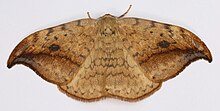Drepanidae
| Drepanidae | |
|---|---|

| |
| Drepana falcataria, the pebble hook-tip | |
| Scientific classification | |
| Kingdom: | Animalia |
| Phylum: | Arthropoda |
| Class: | Insecta |
| Order: | Lepidoptera |
| Superfamily: | Drepanoidea |
| Family: | Drepanidae Meyrick, 1895 |
| Subfamilies | |
|
See text | |
The Drepanidae is a family of moths with about 660 species described worldwide.[1] They are generally divided in three subfamilies (Minet and Scoble, 1999;[2]) which share the same type of hearing organ. Thyatirinae, previously often placed in their own family, bear a superficial resemblance to Noctuidae. Many species in the Drepanid family have a distinctively hook-shaped apex to the forewing, leading to their common name of hook-tips.
The larvae of many species are very distinctive, tapering to a point at the tail and usually resting with both head and tail raised. They usually feed on the leaves of trees and shrubs, pupating between leaves spun together with silk.
Taxonomy[]
- Subfamily Drepaninae – hook-tips
- Subfamily Thyatirinae – false owlets
- Subfamily Cyclidiinae
- Unassigned to subfamily
See also[]
References[]
- Chinery, Michael (1986): Collins Guide to the Insects of Britain and Western Europe
- Minet, J. & Scoble, M.J. (1999): The Drepanoid/Geometroid Assemblage. In: Kristensen, N.P. (ed.): Lepidoptera, Moths and Butterflies Volume 1: Evolution, Systematics, and Biogeography, chapter 17. Handbuch der Zoologie. Eine Naturgeschichte der Stämme des Tierreiches / Handbook of Zoology. A Natural History of the phyla of the Animal Kingdom. vol. IV: Arthropoda: Insecta. Part 35. Walter de Gruyter, Berlin & New York.
- Skinner, Bernard (1984): Colour Identification Guide to Moths of the British Isles
- ^ van Nieukerken; et al. (2011). "Order Lepidoptera Linnaeus, 1758. In: Zhang, Z.-Q. (Ed.) Animal biodiversity: An outline of higher-level classification and survey of taxonomic richness" (PDF). Zootaxa. 3148: 212–221. doi:10.11646/zootaxa.3148.1.41.
- ^ Holloway J.D. (2011). "The Moths of Borneo: Families Phaudidae, Himantopteridae and Zygaenidae; revised and annotated checklist". Malayan Nature Journal. 63: 1–548.
External links[]
| Wikimedia Commons has media related to Drepanidae. |
- CSIRO Images
Categories:
- Drepanidae
- Taxa named by Edward Meyrick
- Moth families
- Drepanidae stubs